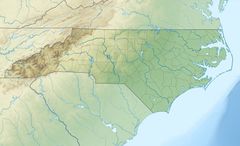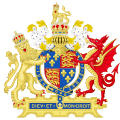مستعمرة روانوك
| Roanoke Colony | |
|---|---|
| Colony إنگلترة | |
| 1585–1590 | |
| ملف:A popular history of the United States - from the first discovery of the western hemisphere by the Northmen, to the end of the first century of the union of the states; preceded by a sketch of the (14781233224).jpg The discovery of the abandoned colony, 1590 | |
Location of Roanoke Colony within what is now North Carolina | |
| التعداد | |
• 1585 | Approx. 108[أ] |
• 1587 | Approx. 112–121[أ] |
| التاريخ | |
| الحكومة | |
| • النوع | Colony |
| Governor | |
• 1585–1586 | Ralph Lane |
• 1587 | John White |
| العصر التاريخي | Elizabethan era |
• Established | 1585 |
• Evacuated | 1586 |
• Re-established | 1587 |
• Found abandoned | 1590 |
| اليوم جزء من | Dare County, North Carolina, United States |
The Roanoke Colony ( /ˈroʊəˌnoʊk/) refers to two attempts by Sir Walter Raleigh to found the first permanent English settlement in North America. The English, led by Humphrey Gilbert, had claimed St. John's, Newfoundland, in 1583 as the first North American English colony by royal prerogative of Queen Elizabeth I. Roanoke was second. The first Roanoke colony was established by governor Ralph Lane in 1585 on Roanoke Island in what is now Dare County, North Carolina, United States.[1] Following the failure of the 1585 settlement, a second colony led by John White landed on the same island in 1587, and became known as the Lost Colony due to the unexplained disappearance of its population.[1]
Lane's colony was troubled by a lack of supplies and poor relations with the local Native Americans. While awaiting a delayed resupply mission by Richard Grenville, Lane decided to abandon the colony and return to إنگلترة with Francis Drake in 1586. Grenville arrived two weeks later and left a small detachment to protect Raleigh's claim.[1] In 1587 Raleigh sent White on an expedition to establish the Cittie of Raleigh in Chesapeake Bay. However, during a stop to check in on Grenville's men, the flagship's pilot Simon Fernandes insisted that White's colonists remain on Roanoke.[1]
White returned to England with Fernandes, intending to bring more supplies back to his colony in 1588.[1] Instead, the Anglo-Spanish War delayed his return to Roanoke until 1590.[1] Upon his arrival, he found the settlement fortified but abandoned. The word "CROATOAN" was found carved into the palisade, which White interpreted to mean the colonists had relocated to Croatoan Island. Before he could follow this lead, rough seas and a lost anchor forced the rescue mission to return to England.[1]
The fate of the approximately 112–121 colonists remains unknown. Speculation that they may have assimilated with nearby Native American communities appears as early as 1605.[1] Investigations by the Jamestown colonists produced reports that the Roanoke settlers were massacred, as well as stories of people with European features in Native American villages, but no hard evidence was produced.[1] Interest in the matter fell into decline until 1834, when George Bancroft published his account of the events in A History of the United States. Bancroft's description of the colonists, particularly White's infant granddaughter Virginia Dare, cast them as foundational figures in American culture and captured the public imagination.[1] Despite this renewed interest, modern research still has not produced the archaeological evidence necessary to solve the mystery.[1]
. . . . . . . . . . . . . . . . . . . . . . . . . . . . . . . . . . . . . . . . . . . . . . . . . . . . . . . . . . . . . . . . . . . . . . . . . . . . . . . . . . . . . . . . . . . . . . . . . . . . . . . . . . . . . . . . . . . . . . . . . . . . . . . . . . . . . . . . . . . . . . . . . . . . . . . . . . . . . . . . . . . . . . . .
خلفية
The Outer Banks were explored in 1524 by Giovanni da Verrazzano, who mistook Pamlico Sound for the Pacific Ocean, and concluded that the barrier islands were an isthmus. Recognizing this as a potential shortcut to Ming China, he presented his findings to King Francis I of France and King Henry VIII of England, neither of whom pursued the matter.[1]
فرضيات عن اختفاء المستعمرة
| ” | It's the Area 51 of colonial history. | “ |
—Adrian Masters (historian, University of Texas)[1] | ||
Without evidence of the Lost Colony's relocation or destruction, speculation about their fate has endured since the 1590s.[1] The matter has developed a reputation among academics for attracting obsession and sensationalism with little scholastic benefit.[1]
Conjecture about the Lost Colonists typically begins with the known facts about the case. When White returned to the colony in 1590, there was no sign of battle or withdrawal under duress, although the site was fortified. There were no human remains or graves reported in the area, suggesting everyone left alive. The "CROATOAN" message is consistent with the agreement with White to indicate where to look for them, suggesting they expected White to look for them and wanted to be found.[1]
تخمين - هجوم الپوهاتان على خليج تشساپيك
David Beers Quinn concluded that the 1587 colonists sought to relocate to their original destination—Chesapeake Bay—using the pinnace and other small boats to transport themselves and their belongings. A small group would have been stationed at Croatoan to await White's return and direct him to the transplanted colony. Following White's failure to locate any of the colonists, the main body of the colonists would have quickly assimilated with the Chesepians, while the lookouts on Croatoan would have blended into the Croatan tribe.
في الثقافة الشعبية

انظر أيضاً
- List of people who disappeared mysteriously: pre-1970
- Timeline of the colonization of North America
- Other failed North American colonies:
ملاحظات
- ^ أ ب The precise number of colonists is disputed. See List of colonists at Roanoke.
المراجع
وصلات خارجية
- Fort Raleigh National Historic Site
- The Lost Colony (1921 silent film)
- The First Colony of Virginia, documents originally from Richard Hakluyt's The Principall Nauigations (1598–1600)
Historical/Archaeological organizations
Coordinates: 35°55′42″N 75°42′15″W / 35.928259°N 75.704098°W
- Missing redirects
- Short description is different from Wikidata
- Coordinates on Wikidata
- Roanoke Colony
- Colonial North Carolina
- تاريخ استعمار الولايات المتحدة
- تاريخ الولايات المتحدة كمستعمرة بريطانية
- الاستعمار الإنگليزي للأمريكتين
- Former English colonies
- Dare County, North Carolina
- Elizabeth I
- تاريخ المستعمرات الثلاثة عشر
- 1580s in North America
- Mass disappearances
- 1580s in the British Empire
- Pre-statehood history of North Carolina
- Ghost towns in North Carolina
- Lost cities and towns
- Missing people
- Unexplained disappearances
- دول وأقاليم تأسست في 1585
- States and territories disestablished in the 1590s
- 1585 establishments in North America
- 1590s disestablishments in North America
- 1585 establishments in the British Empire
- 1590s disestablishments in England
- 16th century in North America
- 1590s missing person cases




